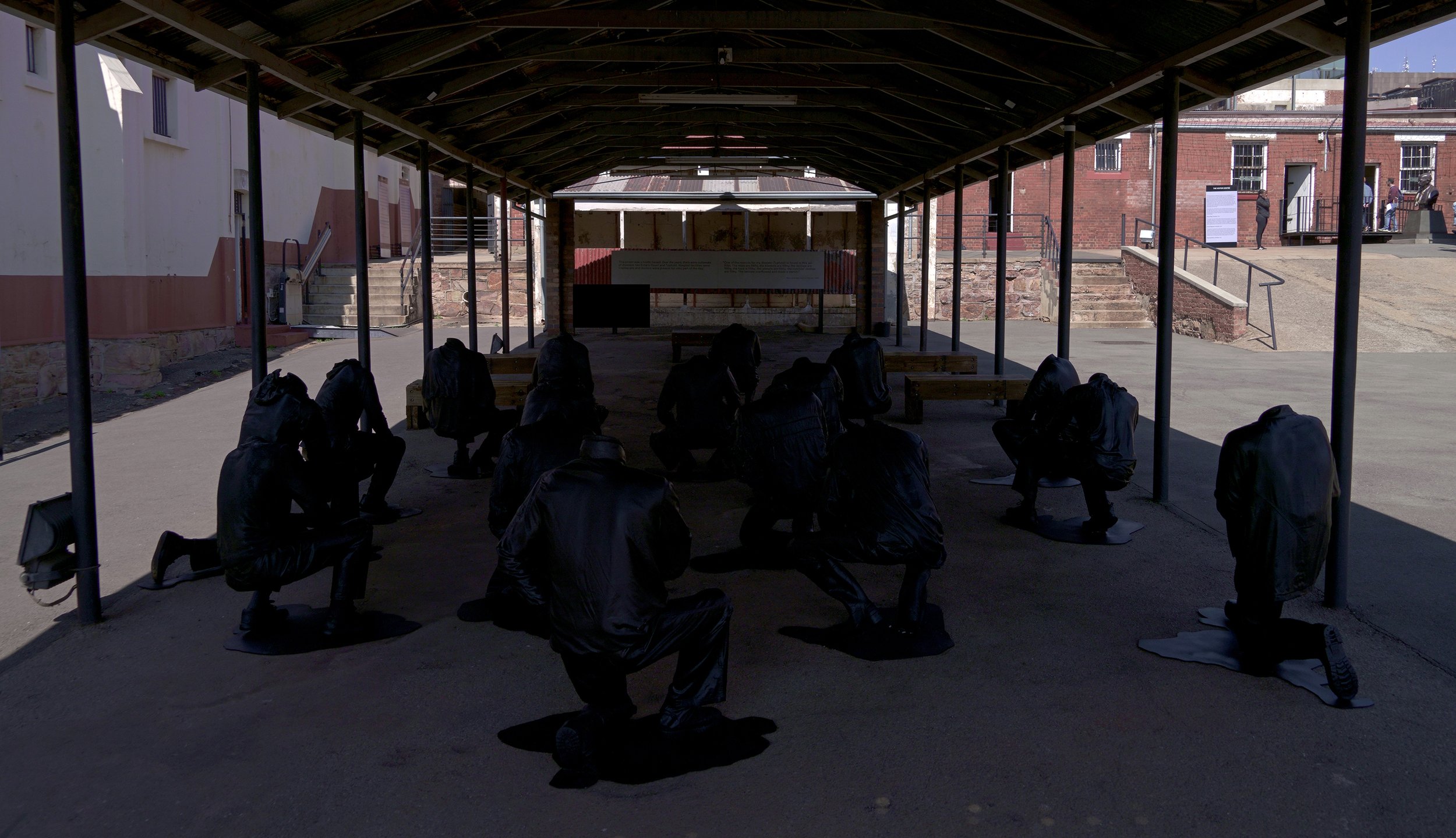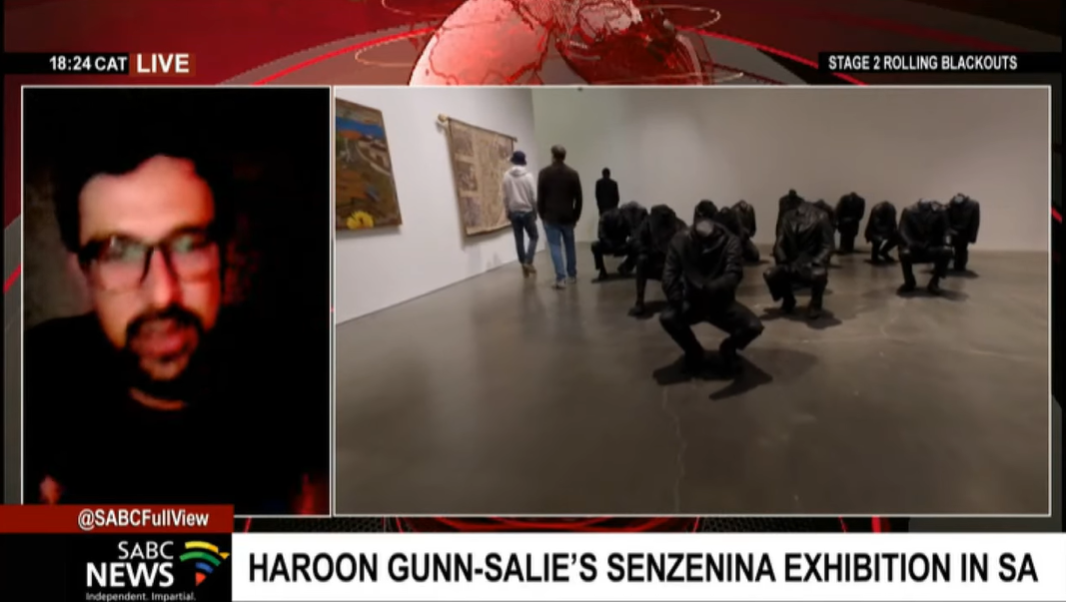SENZENINA AT CONSTITUTION HILL
To mark the tenth anniversary of the Marikana massacre, award-winning artist and activist Haroon Gunn-Salie’s mixed media installation and surround soundscape Senzenina (2018-ongoing) has been installed at Constitution Hill. Installed at Number Four Prison, Senzenina features seventeen life-sized figures cast in resin to resemble the miners struck down at Marikana.
The installation, which runs until 31 October, forms part of a 10 year commemoration event organised at Constitution Hill in partnership with the Socio-Economic Rights Institute of South Africa (SERI). SERI represents the families of 36 striking mine workers who were killed on 13 and 16 August 2012.
“It’s a great honour for Senzenina to be installed at Constitution Hill for this commemoration that’s helping bring renewed awareness to the continued injustice of the Marikana massacre. It’s the first time the work is being exhibited publicly in Joburg, where it was originally made,” says Gunn-Salie.
“Senzenina is a sobering and forceful reminder of what happened at Marikana ten years ago and evokes questions about the massacre as part of South Africa’s wider history of struggle in the face of multiple injustices. Most importantly, it asks us to remember the people who were killed at Marikana,” says Thato Masiangoako, researcher at SERI.
“Marikana was the worst massacre of its kind under our democratic order. 10 years on the families of the 44 men who died, that fateful day are still searching for the truth of what exactly happened to them. This exhibition ensures we do not forget and hold those responsible to account, so that the families know the truth and are able heal and find closure,” says Dawn Robertson, Constitution Hill CEO.
Senzenina premiered at the New Museum Triennial, Songs for Sabotage in New York in 2018. It was later shown at the Frieze sculpture public exhibition in London’s Regents Park in the summer of 2019.
Aligned to ArtJoburg, Gunn-Salie will host a guided tour and discussion about the project.
Saturday 3 September 2022, Number Four Prison, Constitution Hill, 11 Kotze St, Braamfontein, Johannesburg

Senzenina raises questions of multinational and police complicity casting a group of seventeen life-sized hunched and ghost-like figures that seem to cower past the viewer in a display of surrender, incarnating the Marikana massacre, the most lethal use of force by South African security forces against civilians since the 1960s. The mass catastrophe took place on August 16, 2012, when the South African Police Service opened fire on a crowd of striking mineworkers in the Wonderkop sub-district of Marikana. Unionized miners demanded a wage increase at the Lonmin platinum mine and had been protesting for a week prior to the incident, with several casualties occurring even before the massacre occurred. In total, police shot and killed thirty-four, left seventy-eight seriously injured, and arrested two-hundred-and-fifty mineworkers. The state inquiry absolved key political figures accused of having a hand in the events leading to the massacre, with families of the slain miners still seeking reparations, attesting to the irreparable damage caused but not atoned for by the South African government or the company responsible.
Gunn-Salie used police footage of the protesters at the precise moment before police opened fire, also used at the inquest to prove the protest’s peaceable assembly, to cast and memorialize the thirty-four slain in a sculptural graveyard. The installation features a surround-soundscape schematically recreating the scene from archival audio; including calls for the mineworkers to disassemble peacefully; the fortification of the surrounding area and entrapment of the workers by police; an anti-apartheid freedom song lamented by the mineworkers moments before live ammunition was discharged; and blasts from the mine recalled by low-frequency sonic vibrations of the surrounding landscape emanating from an outcrop of granite boulders on the site.
Senzenina installed at Number Four Prison, Constitution Hill, Johannesburg, 2022
Senzenina is proudly supported by
Press
Commemorating the Marikana massacre through an art exhibition - SABC full view with Iman Rapeti
Watch the video
-
Gunn-Salie sculpts the presence of the past
Nkgopoleng MoloiSeventeen figures crouch, headless and handless. There’s singing. Sounds of gunshots usher in expressions of mourning and memory. Upon looking at this work, one feels something akin to sorrow. Your heart breaks —heavily, sharply.
Senzeni na is Haroon Gunn-Salie’s site-specific, mixed-media installation created in response to the 2012 Marikana massacre. The 17 ghosts represent the 17 striking miners killed at what would later be known as scene 1. Through his artistic mirror, the scene is transformed into a pathetic tragedy.
-
Keeping the blinkers off
Tim LeibbrandtMarikana was the foremost crossroads or turning point in our democracy. It was the most lethal strike by state forces since Sharpeville in the 1960s. It was a moment where we as South Africans got to see how fragile our democracy is, and to what extent the police would go to protect the interests – not of the people, not of the workers – but of multinational capital. It showed us where our priorities had misaligned since the end of apartheid, and hopefully it stands as a reminder that the struggle continues, and that Marikana is actually something that’s been happening again, and again, and again to our people since the Native Land act, since the discovery of gold, and since this city was formed. This whole country’s history was turned on its head, and Marikana is indicative of that. I think it was an eye-opener to us all, and I hope that this piece helps to keep the blinkers off.
Haroon Gunn-Salie -
Echoes of the Marikana massacre will be heard at the Joburg Art Fair
Tymon SmithFor his Joburg Art Fair show, Gunn-Salie, being unable to transport the entirety of the work from London, will present the soundscape on its own as part of an immersive installation that takes audiences through the events of the massacre with an extended sound piece that incorporates recorded on-site sound, police recordings and news reports on August 16 2012.
For Gunn-Salie the piece is an attempt to answer the question: "How do you incarnate deep loss and deep trauma into a physical form that can be experienced and accessed and furthermore importantly responded to?"
-
Haroon Gunn-Salie is the FNB Art Prize winner for 2018
As we draw closer to this year's FNB Art Fair organisers have announced Cape Town-born artist Haroon Gunn-Salie at the FNB Art Prize winner for 2018. Gunn-Salie joins the ranks of previous winners such as Nolan Oswald Dennis, Turiya Magadlela, Portia Zvavahera and Kudzanai Chiurai. The Activist's work has been featured in a number of significant exhibitions and projects. His latest work which is a sculptural memorial titled Senzenina has been selected for Frieze sculpture, which runs in London's Regent's Park until the 8th of October. Gunn-Salie joins us now to tell us more about his prize.
-
New Museum Triennial Looks Great, but Plays It Safe
Holland CotterHaroon Gunn-Salie of Cape Town, South Africa, memorializes the 2012 police massacre of striking miners in his homeland with a group of life-size black resin figures and a soundtrack of gunfire and anti-apartheid songs.
-
New Museum Triennial Takes a Global View of Aesthetic Resistance
If there’s a showstopper, it’s South African artist Haroon Gunn Salie’s installation “Senzenina” (2018) on the third floor, which memorializes the 34 striking platinum miners killed in 2012’s Marikana massacre. The crouching, headless figures of the dead, rendered entirely in black, form a powerful elegy that also speaks to crackdowns on peaceful protesters and organizing laborers the world over. A rumbling, abstract soundtrack combining audio of the protests and police shootings adds a visceral dimension to the ominous group of figures.
-
Artist tells what have we done
Nadia NeophytouThat the exhibition opened in the same week as Ramaphosa was sworn in imbues Gunn-Salie’s piece with an unexpected but urgent power. His work is part of the New Museum’s Triennial, an annual group exhibition of young and emerging artists from around the world, the so-called disruptors who use art to address current issues in their societies.
It was an ideal opportunity for Gunn-Salie, exhibiting for the first time in an American museum, to put these questions to the world: What role do multinationals play in tragedies like Marikana and how do they, and those involved in them, share responsibility for the deterioration of sociopolitical and economic conditions in the areas they exploit? His work provokes viewers to think about how they can change a democracy if it is failing its people.
Feedback
We would love to hear from you







